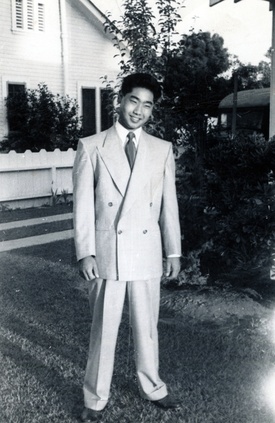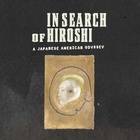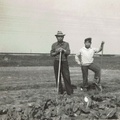I had long thought that I and probably most Japanese Americans of my generation were mental cripples, but I could not define with any precision or clarity the nature of the disability. In 1976 when I first began work on my novel, I found myself breaking down in tears while writing. When I looked at what I had written, the passages did not seem emotional enough to cause such a reaction. One passage that choked me up was about a character who declared to himself, after his father’s death, “I am Japanese.”
During that period I began to have trouble talking to people, especially to groups. My lips would freeze up at unexpected moments, and it was only with the utmost physical exertion that I could make myself talk. There was one occasion when it seemed as if my whole body was rebelling and trying to keep me from speaking. It was in June of 1981, shortly after I resigned as press secretary, when I was invited to deliver a paper at a briefing seminar for the Commission on Wartime Relocation and Internment of Civilians, a body created by Congress to investigate the incarceration of Japanese Americans during World War II.
Even before my testimony I began to feel a constriction in my chest. During my testimony I had to grip the podium to keep myself from breaking down in tears. My chest tightened and it took all the strength I had to get my words out. My voice was hoarse and hardly recognizable. The severity of my emotional reaction was a mystery to me and it made me uneasy, for it was becoming increasingly apparent to me that there were forces residing in me that I was not aware of and that were beyond my control.
When I examined what I said to the commission and tried to extract the essence of what caused such violent emotional reaction within me, it boiled down to the implied statement, “I am Japanese.”
The core of my testimony was an incident at the Gila River Relocation Center where, while watching a war movie together with my friends, I cheered and applauded the sinking of a Japanese battleship. After describing the incident to the commission, I told them that it still filled me with shame: for it was an expression of hatred for the Japanese and, in effect, an expression of self-hatred. I said it was not difficult for me to understand the Black militancy of the 1960s. I could easily understand how a Black man might want to assert his own human dignity, and not see himself, as Franz Fanon said, through the eyes of his oppressor.
For Japanese Americans, our incarceration, based solely on our race, was making us see ourselves through the eyes of our oppressor, white America. We were cheering the sight of a Japanese ship being bombed and its crew leaping for their lives into the ocean.
Later, when the commission held public hearings in several cities, hundreds of Japanese came forth to testify and the usually reserved and undemonstrative Nisei choked back tears or let them flow as they told their stories. Younger Japanese in the audience were amazed to see people of their parents’ generation becoming so emotional. “I never saw Nisei act that way before,” one of them said. Many considered those hearings the most important event in the life of the Japanese American community since the camps. It was as if an entire community was finally mourning its past and revealing its true feelings for the first time in forty years.
I wanted to capture those emotions in my book, but I found I could not do it. Although I was making some progress in dredging up old memories and feelings, I still did not clearly understand those emotions that were welling up in me and in other Japanese of my generation.
Then, in 1982, I got help from an unexpected quarter. National Geographic offered me a contract to write an article on Japanese in America. The editors at the magazine had read a story I had written for The Baltimore Sun on the fortieth anniversary of President Roosevelt signing Executive Order 9066—the act that authorized the internment of Japanese in 1942. I had rewritten my testimony before the congressional commission as a newspaper article for the “Sunday Perspective” section of the paper.
Although the editors at National Geographic had not specified what sort of an article they were looking for, it was my impression that they wanted me to flesh out what social scientists have been saying for years, namely that Japanese Americans are an extraordinarily successful ethnic group, in fact a “model minority.” I traveled to New York, Chicago, Los Angeles, San Francisco, Seattle, and Honolulu and interviewed more than a hundred Japanese of all ages and in a wide variety of occupations.
At first I looked for success stories: a multimillionaire, lawyers working in white firms, a television anchor person, a rock band leader. But after a short while, I was no longer interested in writing about a model minority. I was not interested in writing at all. I wanted only to talk and listen to other Japanese.
In New York I met Takeru Iijima, a retired music teacher, who was a first sergeant in the all-Nisei 442nd Regimental Combat Team. He was drafted on December 4, 1941, just three days before the attack on Pearl Harbor. After that, he said, the Army didn’t know what to do with him and he was transferred from one camp to another and given menial assignments until the 442nd was formed.
He said there might have been others who wanted to prove they were loyal Americans, but he did not think he had anything to prove. “I wanted to survive and get back home. That was the only thing on my mind.”
He did survive the fighting in Europe and returned home to New York. He got a degree in music education but could not get a teaching job even though there were jobs available. He worked as an unskilled laborer for four years until finally in 1950, he got a teaching job at a school in the South Bronx. “The principal took me only out of desperation,” he said. “Nobody wanted to go there.”
When he retired 26 years later, he was chairman of the music department at the Thomas Jefferson High School in Brooklyn, but he was bitter about his wartime experience and the prejudice he faced after his return from the Army. “If I had to do it all over again,” he said, “I’d say, ‘Hell no.’”
I talked to his son Chris who, while attending Columbia University in the 1960s, engaged in anti-war demonstrations. While he was on the street shouting, “Hell no, we won’t go,” he said, it was inconceivable to him that his father was in the 442nd. “It was galling to me until I finally understood what they were trying to do,” he said.
It was the anti-war movement that got him interested in Japanese American history and the history of other non-white people. “For me, it was a revelation,” he said. “It was the turning point of my life. I began to identify more with the Vietnamese than with the American soldiers. I began to identify with Puerto Ricans, the Blacks, and other Asian Americans.” He said he also began to understand Japanese Americans of his father’s generation. “They had a gun to their head.”
I talked to Grant Ujifusa, a Harvard-educated, third-generation Japanese, who was working in New York as an editor for a large book publishing house. He was originally from Worland, Wyoming, where his grandparents had settled, so he and his family had been spared the camps. But he said he had an image of the “hypothetical trauma.” He would not have had personal recollections of the camps because he was an infant at the time, but he said:
“It would have scarred me. I would have experienced it later, when I was four, when I was ten. It would have been part of my life. It would have flowed in my veins as it has for most Japanese Americans.... If you cut my family off at the knee, you cut me off at the knees. My sense of manhood comes from my grandfather and father. If you emasculate them, you emasculate me.”
In Los Angeles, I looked up Dan Kuramoto, the leader of the Hiroshima rock band, which used a mixture of western and Japanese instruments. While clearly western, the music the band played had traces of Japanese rhythms and melodies. I found Kuramoto, a third-generation Japanese American, to be a shy, soft-spoken man.
During our conversation, I told him about my discomfort with seeing Japanese in groups, and he said he felt the same way. He said that he, too, had not come to terms with his own race and that performing on stage with other Japanese, using Japanese instruments and naming the group Hiroshima, was his way of combating his inherent timidity. He resembled a man who becomes a lion tamer to conquer a fear of lions. “lt’s my way of meeting a difficult issue head-on,” he said.
Seeing my own Nisei generation from across generational lines helped me. The third-generation Sansei gave me hope, for they were so much further along than Nisei in figuring out the Japanese American puzzle: what’s wrong with us? Why are we so fearful?
Dwight Chuman, a Sansei journalist in Los Angeles, called the Nisei of the 1940s “confused young men, who succeeded by selling their self-hatred and disappearing in the mainstream mentality.” He referred to the model minority image, “The Quiet American,” the smiling, hard-working, reliable professional Mr. Nice Guy.
He made me think of how hakujin, upon meeting me, would often ask whether I knew a certain Japanese American acquaintance of theirs. “You happen to know George...?” a man would say. “A real nice guy.” It seemed to me that we were all nice guys and it would be a relief for me to find a Nisei who was mean, ornery, loud-mouthed, dishonest, and unreliable.
Amy Iwasaki Mass, a Nisei clinical social worker, was six years old when she was sent with her family in the camp at Heart Mountain, Wyoming. She said for years she remembered the internment as a “fun” experience and it was only in psychoanalysis that her true feelings came pouring forth. In working as a therapist with other Nisei, she said, she discovered that they, too, had repressed much of their feelings surrounding the experience.
Repression, she said, was our means of protecting ourselves from the frightening realization that our government was acting against us. The pleasant, non-offensive manners of most Nisei, their neat grooming and appearance, their exaggerated concern or surface qualities are largely protective coloration, she said.
To be continued... >>
*This is an excerpt from the revised edition of In Search of Hiroshi by Gene Oishi (2024).
© 1988 Gene Oishi






